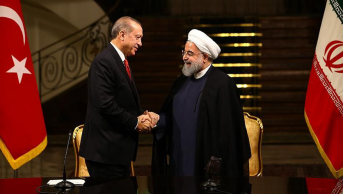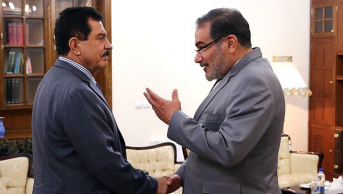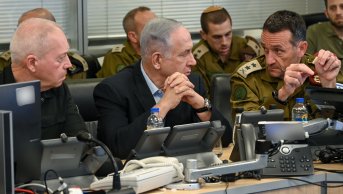Iranian Politics after Rafsanjani

Ayatollah Khomeini, the leader of the Iranian revolution, issued a message regarding the assassination attempt against Ali Akbar Hashemi Rafsanjani in May 1979, and stated, "The evils should know that Hashemi is alive because the (Islamic) movement is alive." Hashemi died onJanuary 8, 2016,however, the fate of the Islamic movement and the 'revolution' isquestionable.
Some people argue that the revolution is institutionalized and settled down with the establishment ofIslamic Republic. According to someothers, the revolution was already over when the Islamic Republic was established. The death of Rafsanjani will flamethe debates on the fate of the revolution and the Islamic movement, andthe future of the Islamic Republic.
Rafsanjani in Iranian Politics
Rafsanjani, who wasrelatively inactivebefore therevolution but played an important role in the mobilization of ulama, came to the forethroughout the establishment of Islamic Republic. Together with Ayatollah Beheshti and HojatoleslamAli Khamenei, he became one of the three prominent leaders of the Islamic Republican Party that shapedthe new regime. Beheshti was killedin a terrorist attack in 1981. Khamenei held the presidential office, while Rafsanjani served as the speakerof the parliament during the 1980s.
Rafsanjani’s power was largely derived from Ayatollah Khomeini’s confidence in and support for him.Rafsanjani representedthe ‘reason of state' against the extremists through the process of the consolidation of regime. On some occasions he stood with the leftists, while on some other occasions sided with the conservatives. He was at the centre of the Irangate scandal. He played a critical role to end of the Iraq war, andresuscitated the Iranian nuclear program.
He experienced both the topand the bottom of popularity throughout his political career ... He received more than 90 per cent of the casted votes in the presidential elections in 1989, but he could not have secured enough votes to become a deputy in the parliamentary elections in 2000.
Both his political activities, and his family were always parts of intensive public debates. He was held responsible for the assassination of opponents of the regime, inside or outside Iran. He liberalized the Iranian economy and opened it to international markets. For this reason, his supporters called him the 'Commander of Reconstruction' (Sardar-e Sazandegi), whereas his opponents called him “Akbar Shah” due to his ever-growing political and economic power. Some saw him as a symbol of degeneration and corruption. That's why he was at the centre of stories on 'millionaire mullahs'. The scholarly career of Rafsanjani, who came from Iranian ulama, is also controversial. While his supporters called him an Ayatollah, in his message of condolence the Leader Khamenei recalled him with a lower rank, ‘Hojatoleslam.’
Technocracy and Moderation
Because he was always one of the leading figures in Iranian politics, and because of his pragmatism, it is not easy to name his political affiliation. His standwas always named under different political factions. Soon after the death of Khomeini, he allied with conservatives and purged the Islamic leftists and extremists from power. Underhis administration, technocracy rather than political movements,and moderation in political discourse became prominent. For this reason, he was seen asprotector of technocrats and 'moderates'. In order to curb rigid attitudes of the conservatives, he acted together with technocrats and reformists.
He was severely criticized by many reformers due to corruption charges, and his role in political assassinations etc..He stood up as the last hope of the reformers against Mahmoud Ahmadinejad in the second round of the presidential elections in 2005, but helost. He won the sympathy of some reformist opposition because of the covert support he gave to the Green Movement that appearedin 2009. He supported his close colleagueHassan Rouhani during the last presidential elections and the February elections for the parliament and the Assembly of Experts. Rouhanicould have garnered the support of the reformists in this process. Thus, an alliance has been formed among technocrats, moderates and reformists.
Technocrat-Reformist Alliance
It is hard to say that Rafsanjani was a popular leader. Besides his wealth, his political power was based on three important bases. First, his close relations with Ayatollah Khomeini helped him gain a great respect among the revolutionary Islamic circles. The second is the crucial roleshe playedin the establishment of the regime andthe subsequent years. He was, after all, the black box of 37 years after the revolution in Iran. This gave him a reputation for being one of the founders of the regime and gave him a great power. As a matter of fact, the historical anecdotes that he delivered from time to time became the hot topicin Iranian politics and set the agenda. The third source of Rafsanjani's support is his influence on bureaucracy and technocrats. Hebecame a respected leader and he was followed due to his steps in the direction of development and reconstruction under his presidency, the cadres he helped to settle in Iranian bureaucracy, and because he was believed to represent the reason of state.
Rafsanjani in his later times, andthe political trend represented by him came closer to the reformists because of the three reasons. First, they agreed to keep values and institutions that represent the 'republic' in the Islamic Republicanregime. Monopolization of power in the hands of one single person,the supreme leader, and the constraints imposed on manoeuvre capability and authority of the elected president and the parliament in the name of building 'Islamic order' and preserving 'Islamic values',was spoiling the 'Islamic Republic.' In this regard,the technocrats and the reformists corresponded on the preservation of authorities of elected representatives, rule of law, human rights, freedom of press, etc..The second reason was the fact that the reformist movement was very weakened and marginalized. The reformist leaders and the leaders of the Green Movement,Mir Hossein Mousavi and Mahdi Karrubi are still under house arrest. The former president, Muhammad Khatami, is deliberately kept away from public view. Many of the religious intellectuals that formed intellectual foundations of the reformist movement fled abroad. Under these circumstances, both Rafsanjani and Rouhani became champions of the reformist hopes. Another factor that unitedthe technocrats, Rafsanjani's followers, and the reformists is their agreementto pursue 'rational' and moderate' policiesin foreign relations instead of ideological struggle and aggression.
The technocratic-reformist alliance is likely to continue after the death of Rafsanjani. His funeral already showed that the alliance is alive. More than two million people attended the funeral, and slogans were shouted in favour of Mousavi, leader of the 'Green Movement'. As a matter of fact, it seems difficult for the reformist to raise a new leader among themselvesunder current conditions. Therefore, it is likely that the technocrats, the moderation front, and the reformistsget together around President Rouhani, which will culminate in consolidation of his power.
Khamenei’sstrife for balancing, and the opportunity for Rouhani
Afterthe death of Rafsanjani, only Khamenei of the trio that played critical roles in the establishment of the regime is alive. Khamenei, whoascended to the office ofSupreme Leader with the support of Rafsanjani in 1989, consolidated his strength over time and monopolized power in his own hands. However, Rafsanjani was still seen as a leader that could balance him. Now, in his absence, it is clear that Khamenei will be stronger.
There are two points to be considered here. First, Rafsanjani's power should not be exaggerated. Despitehis so-called power, his children were imprisoned for various reasons.His bid for candidacy in the presidential elections of 2013 was rejected. Although he received most of the votes in the last elections of the Assembly of Experts, Ayatollah Jannatihas taken the chairmanship of the council. The second is balances within the regime. Although the poweris monopolized in the hands of the Supreme Leader Khamenei, known for his conservatism, various factions that differed on some points continue to claim for power. The ulama, Revolutionary Guards, bazaar and other pressure groups are trying to influence politics in different ways. Underthese conditions, Khamenei, as the leader of the country, will likely try to remainabove factions as much as possible and to maintain a balance between themwith regard to sharing power. Thiscaution is crucial for the preservation of Islamic Republican regime.
In many circles, it is thought that President Rouhani lost his protector and became lonely after Rafsanjani’s death. However, Rouhani is close to the Leader Khamenei as much as he is to Rafsanjani and it is difficult to fit him in a certain political faction just like Rafsanjani. After Rafsanjani's death, Rouhani was deprived of a significant support in the face of his opponents; nevertheless, this development can pave the way forRouhanito be the leader of the technocratic-reformist coalition.Aside from discussions on flattening of the revolution, the prospective consolidation of Rouhani’s power in Iranian politicswill serve to institutionalizethe regime of Islamic Republic that claims to have taken its legitimacy from the revolution.
This article was published on the web page of Al-Jazeera Turk with the title "RafsancaniSonrası İran Siyaseti.





